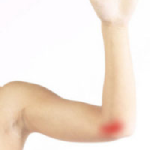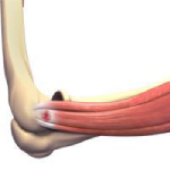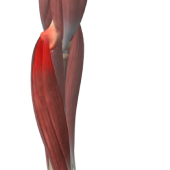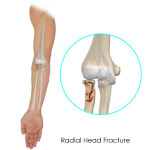Elbow Conditions
- Anatomy
- Conditions
- Procedures
Cubital Tunnel Syndrome (Ulnar Nerve Entrapment)
When the elbow is bent, the ulnar nerve can stretch and catch on the bony bump. When the ulnar nerve is compressed or entrapped, the nerve can tear and become inflamed, leading to cubital tunnel syndrome.
Elbow (Olecranon) Bursitis
The elbow contains a large, curved, pointy bone at the back called the olecranon, which is covered by the olecranon bursa, a small fluid-filled sac that allows smooth movement between the bone and overlying skin.
Osteochondritis Dissecans of Elbow
Osteochondritis dissecans is a joint condition in which a piece of cartilage, along with a thin layer of bone separates because of inadequate blood supply. The separated fragments are sometimes called “joint mice”. These fragments may be localized or may detach and fall into the joint space, causing pain and joint instability.
Elbow Sprain
An elbow sprain is an injury to the soft tissues of the elbow. It is caused due to stretching or tearing (partial or full) of the ligaments that support the elbow joint.
Tennis Elbow
Tennis elbow is a common name for the elbow condition lateral epicondylitis. It is an overuse injury that causes inflammation and microtears of the tendons that attach to the lateral epicondyle.
Golfer's Elbow
Golfer’s elbow, also called medial epicondylitis, is a painful condition occurring from repeated muscle contractions in the forearm that leads to inflammation and microtears in the tendons that attach to the medial epicondyle.
Elbow Injuries
The elbow is a complex joint formed by the articulation of three bones – the humerus, radius, and ulna. Articular cartilage lines the articulating regions of the humerus, radius, and ulna. It is a thin, tough, flexible and slippery surface that acts as a shock absorber and cushion to reduce friction between the bones. The bones of the elbow are supported by ligaments, tendons, muscles, nerves and blood vessels.
Little League Elbow
Little league elbow, also called medial apophysitis, is an overuse condition that occurs when there is overstress or injury to the inside portion of the elbow. It is commonly seen in children involved in sports activities that require repetitive throwing such as baseball.
Elbow Pain
The elbow is a hinge joint made up of 3 bones – the humerus, radius, and ulna. The bones are held together by ligaments to provide stability to the joint. Muscles and tendons move the bones around each other and help in performing various movements. Nerves pass through the joint. Damage to any of the structures that make up the elbow joint can cause elbow pain.
Radial Head Fractures of the Elbow
Radial head fractures are very common and occur in almost 20% of acute elbow injuries. Elbow dislocations are generally associated with radial head fractures. Radial head fractures are more common in women than in men and occur more frequently in the age group of 30 to 40 years.
Elbow Fractures
Elbow fractures may occur from trauma, resulting from various reasons: a fall on an outstretched arm, a direct blow to the elbow or an abnormal twist to the joint beyond its functional limit.
Elbow Trauma
The elbow is a complex joint of the upper limb, formed by the articulation of the long bone of the upper arm or humerus, and the two bones of the forearm - the radius and ulna. It is one of the important joints of the upper limb and is involved in basic movements such as bending and extending the arm and rotating the forearm.
Bicep Tendon Tear at the Elbow
A biceps tear can be complete or partial. Partial biceps tendon tears will not completely break the tendon while complete tendon tears will break the tendon into two parts. Tears of the distal biceps tendon are usually complete and the muscle is separated from the bone. Tears of the distal biceps tendon most often result from a sudden injury or lifting a heavy object.
Triceps Tendonitis
Triceps tendonitis is inflammation of the triceps tendon, the tissue that connects the triceps muscle on the back of the upper arm to the back of the elbow joint, allowing you to straighten your arm back after you have bent it.
Loose Bodies in the Elbow
Your elbow is a joint made up of three bones held together by muscles, ligaments, tendons, and cartilage. It is both a hinge and pivot joint allowing you to bend and rotate your elbow freely. Loose bodies in your elbow are small pieces of bone or cartilage that have broken off and are lying or floating free within the joint. They can make elbow movement such as bending or rotation difficult.
Throwing Injuries
An athlete uses an overhand throw to achieve greater speed and distance. Repeated throwing in sports such as baseball and basketball can place a lot of stress on the joints of the arm, and lead to weakening and ultimately, injury to the structures in the elbow.



































